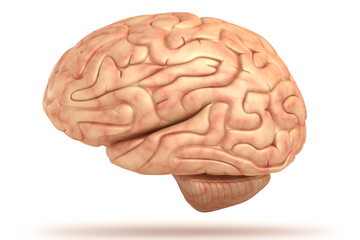The brain (Encephalon, الدماغ) is a vital life determining organ located in the skull and is responsible for essential functions such as thought, action, vision, movement, reasoning, recognition, emotions, planning, body orientation, problem solving, learning, memory and speech, etc…
The brain is made of three main parts or sections:
- Forebrain
- Mid brain
- Hindbrain
The forebrain consists of the cerebrum, thalamus and hypothalamus, the mid brain and the hindbrain consists of the cerebellum, Pons and medulla; the brain is divided into two hemispheres that look symmetrical but function differently as the left side of the brain controls the muscles of the right side of the body and vise versa.
Cerebrum or cortex is the largest part of the brain (Dr. Diab) associated with higher brain functions such as though and action, anatomically the cortex is a highly wrinkled surface area divided into two hemispheres, right hemisphere responsible for imagination and creativity and left hemisphere responsible for logic, scientific reasoning and math,
According to The Canadian Institute of Neurosciences, Mental Health and Addiction the cortex is divided into four lobes or sections ( 1- frontal lobe responsible for reasoning planning, movement, problem solving and emotions, 2- occipital lobe associated with vision, 3- temporal lobe associated with recognition of auditory stimuli, memory and speech, 4- parietal lobe associated with movement and body orientation).
The cortical area is also divided into four sections, responsible for the following functions:
| Cortical area | Function | |
| 1 | Sensory stimuli | Relaying info from receptors |
| 2 | Primary sensory area | Processing of sensory input |
| 3 | Association area | Integration and interpretation of sensory input |
| 4 | Primary motor area | Transmission of impulses to somatic motor neurons |
The brain is the command center for the human nervous system (Emc, 2014) responsible for perception (awareness and interpretation of the sensation) and sensation (awareness of external and internal stimuli). Humans have 5 main sensory systems: touch (temperature, pain, pressure…), vision, hearing, taste and smelling.
Aphasia a speech disorder characterized by the inability to use or understand language be it spoken or written such as Broca’s aphasia, non-fluent aphasia and wernicke’s aphasia.
Broca’s area is located in the frontal lobe, it is responsible for the production of fluent speech, patients with Broca’s aphasia know what they want to say but they can’t get it out, while patients with non-fluent aphasia are not able to speak fluently. Symptoms for Broca’s disorder include difficulty in pronunciation, word finding, performing the output functions of speech.
wernicke’s area is located in the temporal lobe, it is responsible for speech comprehension, in patients with wernicke’s aphasia the speech is present but the language content is not correct, example insertion of incorrect or imaginary words.
Concluded a dead brain is equivalent to a dead person whereas lesions in the brain will result in different outputs related to the affected area, a lesion in the temporal lobe will result in losing the ability to interpret non-verbal auditory stimuli, such lesions interfere with the recognition, memory and language, while a lesion in the parietal lobe will lead to disorientation of environment space and the inability to write. A lesion in the occipital lobe will lead to blindness whereas damage in the frontal lobe will lead to impairment of memory, the inability to concentrate, difficulty in acquiring new information (impairment of learning) and motor damage.
Reference
- emc.healthyorthodoxmedicine.com
Verified by: Dr.Diab (January 7, 2017)
Citation: Dr.Diab. (January 7, 2017). The brain, its anatomy and functions. Medcoi Journal of Medicine, 4(2). urn:medcoi:article15410.














There are no comments yet
Or use one of these social networks